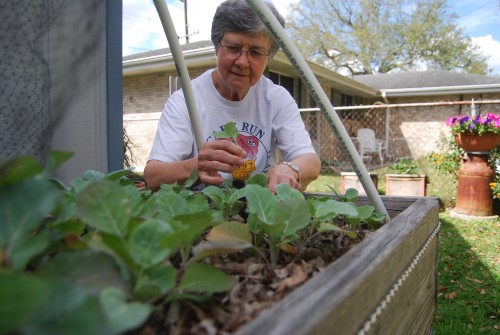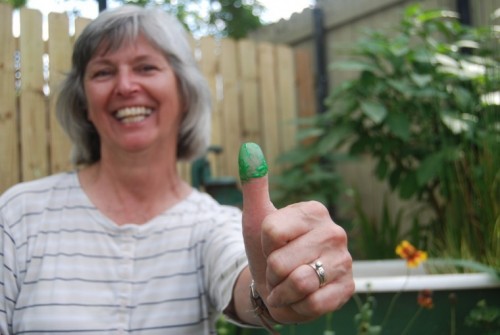
Fried pork Champ urges competition
April 3, 2012
Short on green space? Don’t fret!
April 3, 2012Even with a king-size concrete slab that makes a menace of the Helmers’ backyard, the Houma couple is able to keep their kitchen stocked with homegrown tomatoes, potatoes, peppers, broccoli, herbs and, well, the list goes on.
It’s not about square footage of space, they insist, but parallel goals of perfecting an art form and efficiently utilizing the remaining greenery. It’s the installation of drip irrigation, the effective use of sunlight and the “don’t-forget-to-rotate-the-crop” mentality the Master Gardeners have cultivated as much as the vegetables themselves.
“To best use your green space, your grass, is to find ways around your house, those little nooks and crannies to stick your gardens in,” says Joel Helmer.
Joel and her husband, Chuck, Houma and Iowa natives, respectively, each grew up in families who emphasized horticulture. Now they maintain tidy swaths of gardens that lay in strips around three sides of their home.
“Whether you liked it or not, as a child, you (helped with the garden),” Joel says. “Now, we love it and have passed it on. Both of (my grandparents) lived downtown and didn’t have a purse of property, so I always knew that you can get in small areas.”
Not only have they carved out the space; the seeds have proven bountiful. The Helmers say they picked 200 pounds of tomatoes one summer, plus the usual glut of okra, cucumber, peppers, potatoes, sweet peas, thyme and basil.
It would be a shame to let all the food go to waste, so the Helmers don’t. Chuck claims to make a delicious green tomato cake, similar to a carrot cake, and he’s more than willing to swap veggie recipes with friends and family. The gardeners don’t shy away from instructing other locals on the different ways to save their hauls.
“We try to come up with some ways that they can either preserve their produce or use it in a recipe that maybe they haven’t thought of using,” Chuck says.
“Last year we made salsa, Rotel, and spaghetti sauce,” Joel adds. “It’s easier, like when the kids come in from out of state, we can give them the jars (of preserved tomatoes) to take back. They come back about two months later and go straight to the pantry. ‘Here’s your jars, can I have more?’”
The duo also exchanges produce with neighbors. A group from church supplies the Helmers with citrus in return for bell peppers. The man across the street supplies their firewood for the winter and receives tomatoes in the summer.
“To me, this reminds me more of the way I was raised as a child – giving back to your community and working together,” Joel says.
Their years-long path to successful gardening was littered with trial and error, but it has led them to discover efficient techniques.
For tomatoes alone, the Helmers weave a string around the stalks to give the plants support, use weed blocker on their plot that receives morning sun and implement a drip irrigation system to shoot water directly at the roots, saving the leaves from water-borne disease and reducing the amount of weeds that soak up excess water.
There’s also the matter of rotating their crops. Some plants, like tomatoes, can be planted in the same soil each season, but others need to be rotated. Okra and cabbage fall into the latter category, so the Helmers are experimenting with ears of corn this spring.
“We normally don’t grow corn, but we’re growing the corn because we want to put the okra back there afterwards,” Joel says. “And it’s just one little season. It doesn’t have to be six months; it can be a crop within three months.”
Amateur gardeners need not panic. Although the amount of tips may seem overwhelming, help is often easy to find. Terrebonne Parish alone has about 75 Master Gardeners, who are certified through a class offered at the LSU Ag Center Terrebonne Extension.
The Ag Center also posts publications online at its website, and Barton Joffrion, the center’s county agent, said gardeners in any capacity are welcome to call the center at (985) 876-6495 or bring plants to the site at 511 Roussell St., Houma.
Spring planting season began for many vegetables last month, but it’s not too late for those with an undeveloped green thumb to try their hands at harvesting crops.
Planting deadlines for cucumbers, hot peppers, bell peppers, sweet potatoes, tomato plants and watermelons range from May to August, according to the LSU Ag Center, but in the south Louisiana climate, assorted crops will be in season until December.
“If you like being outside on a beautiful day and you start digging in the dirt or something, it’s just – especially when you start growing from seeds, they’re propagating and you see that grow – it just amazes you to see that little bitty seed and then all of a sudden you’re pulling bell peppers or tomatoes off of something,” Chuck says.
– editor@gumboguide.com
Joel Helmer shows off her green thumb. Joel first became acquainted with horticulture through her grandparents, who were home gardeners at their downtown Houma residence.
Joel and Chuck Helmer stand near their backyard garden.
In order to prevent their tomato plants from tipping, the Helmers use a Florida weave. As the plants grow, the string, wove through stakes with a PVC pipe, is raised, Chuck says.
Chuck shows off his drip irrigation system, which can funnel between half a gallon and 10 gallons of water per hour directly to the plants’ roots.
For crops that receive an abundance of morning sunshine, the Helmers recommend installing some sort of weed barrier. Chuck points out the shade cloth around the Helmers’ tomato plants.











